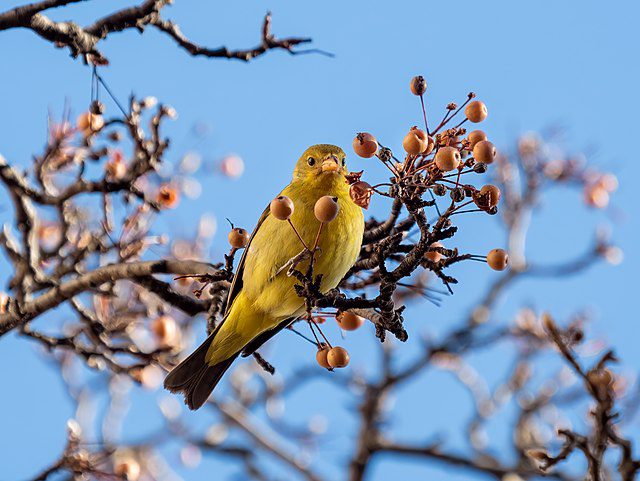
Crested Tern photo by JJ Harrison-Wikimedia Commons.
25 Interesting Facts about Birds
Birds are among the most amazing animals on the earth, and they come in a huge range of colors, sizes, and forms.
One of the most fascinating animals in the world is the bird. They have amazing colors and are covered with feathers. We have more than 18,000 kinds of birds on the earth, from hummingbirds to perching birds.
Certain birds can leap, run, and swim, and many birds can fly. Several of them are extremely strange. How much do you actually know about them, though? The following list of 25 interesting bird facts may surprise you.
1. The only creatures with feathers are birds

Lesser Black-backed Gull photo by Diliff-Wikimedia Commons.
Birds differ from other animals in part because of their feathers. While the majority of birds can fly, others, like ostriches and penguins, cannot.
On the contrary, only birds have feathers; all birds do. The only bird in the world without wings, while possessing feathers, is the New Zealand-born Kiwi.
The primary function of a bird’s feathers is flying. Each feather’s base has muscles that let them move when flying.
Moreover, feathers assist birds to maintain their body temperature and draw mates. They have water-resistant feathers, in case you didn’t know. In the event of rain or water, this helps to keep them dry.
2. Every female bird lays an egg

Female Southern Masked Weaver photo by Prosthetic Head-Wikimedia Commons.
A female bird can lay eggs whether or not she has a partner. For instance, hens with red earlobes usually lay brown eggs. The hue of the eggs and the color of the red ear lobes are linked genetically.
The green or blue eggs are laid by Araucana and Ameraucana chickens. The hummingbird produces the tiniest bird egg.
In order to be ready for egg-laying and caring for their offspring, female birds often increase their reproductive activity in response to environmental changes.
The young birds develop after they deposit their eggs and emerge from their shells. To care for their offspring and to incubate their eggs, birds build nests.
3. More than 18,000 different bird species may be found worldwide

toucan bird park photo by Julio Cesar R. Lopes-Wikimedia Commons.
There are many different kinds of birds around the globe. The average estimate of the number of bird species by scientists is above 10,000. A new study, however, indicates that there are around 18,000 different bird species worldwide.
According to the British Ornithologists Union, there are 628 different bird species in the UK. There are 1120 distinct species of birds in the US.
According to studies by National Geographic, there are between 50 billion and 430 billion birds in the globe.
The majority of bird species are perching birds, or “passerines,” which are distinguished by the peculiar arrangement of their feet. They have one toe pointing backward and three toes pointing forward.
4. Birds congregate to defend one another

London : Kensington Gardens – Birds around the Round Pond photo by Lewis Clarke-Wikimedia Commons.
The birds in a flock all come from the same species and move in unison. Many animals can benefit in different ways from flocking.
Most species benefit from protection from predators. Because they can all see in various directions when they flock, it helps them stay vigilant.
While a flock is spinning about, a predator may get disoriented or perplexed, making it challenging to focus on a single victim.
Flocking has added advantages for other species, such as geese. The geese’s V formation helps them use less energy when flying.
The bird at the back feels the impact of the air as the bird in front flaps its wings. However, this is useful when a bird is injured or smaller in size.
5. There are birds on every continent of the world

Western tanager photo by Rhododendrites-Wikimedia Commons.
Birds are the only animals that may be found on every continent in the world, including South America, North America, Africa, and many more.
There are hundreds of different kinds of birds. Birds may live in a variety of habitats. When the seasons change, they also move from one environment to another in search of food or refuge for their young.
6. Among all land animals, the ostrich possesses the biggest eyes

Ostrich (Struthio camelus) portrait at the Whipsnade Zoo in Bedfordshire, England photo by William Warby-Wikimedia Commons.
Eye contact is hard to avoid when an ostrich is staring at you. Among all land animals, the ostrich possesses the biggest eyes. The bird’s eyes are five times larger than human eyes and bigger than its brain.
The largest bird in the world is the ostrich. This non-flying bird is renowned for its long neck and impressive sprinting abilities. In the wild, their huge eyes and strong legs let them flee from predators.
The biggest bird in the world, the ostrich, also produces the largest bird egg. Apparently, 2.5kg is the maximum weight for the biggest eggs.
7. Dinosaurs gave rise to birds

Amur Falcon photo by Bernard DUPONT-Wikimedia Commons.
The story of the extinction of the dinosaurs is intriguing and puzzling. But perhaps more intriguing is what they left behind. Theropod dinosaurs are a group from which birds descended.
The well-known Tyrannosaurus rex belongs to this same group. The Archaeopteryx, which lived in the Jurassic era around 150 million years ago, is the oldest bird that has ever been discovered.
They had the appearance of little feathered dinosaurs. Even teeth were present. Yet according to experts, these birds lost all of their teeth and developed beaks.
8. Several bird species can mimic human speech
Parrots and other birds can mimic human speech. The most chatty and intellectual parrot is the African Gray, which is also one of the most talkative. Because of its impressive brain ability, one parrot could imitate hundreds of phrases.
These birds can copy words, according to research, and utilize them to communicate with their owners. Strangely, ravens may imitate their predators’ noises in the wild to draw them to corpses that they are unable to open.
Some ravens are also capable of imitating human speech and environmental noises. These birds are more intelligent than other birds; they have the mental and emotional maturity of a 5-year-old human kid.
9. Some birds sleep with one eye open
Ducks have a single-brain sleeping pattern in which only one-half of their brains sleep while the other half is up and active.
As ducks are gathered together to sleep, the ducks on the outside ring keep one eye open to keep an eye out for nearby predators.
Mallard ducks have more irregular sleeping patterns. They snooze with one eye open and one leg in the water. They do this in order to keep warm when they roost on water.
10. Wandering albatrosses can fly as they sleep
With the largest wingspan of most birds in the world, albatrosses are among the largest seabirds. This bird has the ability to glide smoothly for extended periods of time without flapping its wings.
They achieve this by using the wind energy stored beneath their wings. They may travel hundreds of miles while consuming squid and fish.
It’s interesting to note that baby albatrosses can live for years at sea without ever setting foot on land. Even more amazing is the fact that this bird can briefly fall asleep while flying.
11. Hummingbirds can’t walk
When you’re a bird that can fly backward, you have to make certain sacrifices. Hummingbirds have extremely small, non-locomoting feet as a means of reducing drag.
While they can sit and move a little side to side on their legs, their legs are not meant for extensive treks
12. Hoatzin chicks have claws on their wings
Two claws can be found on the wings of the juvenile hoatzin, also called stink birds. To climb tree branches and get themselves out of the water, they utilize their claws.
As a defense against danger, they also utilize their claws. As danger approaches, the juvenile hoatzin leaps from its nest and into the water.
Then, they climb onto land using their claws. When everything is safe, they crawl up to a tree branch using their claws.
13. Crows are able to identify human faces
You might not want to engage in conflict with crows. The raven family includes crows, which are extremely clever birds.
They are even capable of navigating in areas where there are people. They even lament the loss of their relatives.
14. Penguins are capable of doing 9-foot jumps
A penguin moves forward upright. They are proficient swimmers and spend most of their life at sea. The only bird that cannot fly is them. They are great jumpers, though.
A penguin may leap onto the land from the water up to nine feet in the air. Penguins can occasionally jump to enter the water more quickly when they approach it.
By swimming extremely quickly, they may even leap out of the sea and onto land. These lovely animals have a black-and-white pattern that serves as camouflage.
These critters are also able to swallow a large number of fish in a single day due to the spines that surround their mouths and help guide the fish down their throats.
15. Birds’ metabolic rates are quite high
Birds have high metabolic rates because they use large amounts of energy. The metabolic rate of passerines is greater than that of non-passerines.
The heart rate is one sign of metabolic rates. When a hummingbird is fully in flight, its heart rate can reach 1260 beats per minute. The tiniest bird in the world, the bee hummingbird, has the greatest metabolic rate.
16. Birds use color and sound to communicate
You’ve probably heard birds squeaking or whistling when strolling through a park or other natural area. The sound is the exchange of messages between birds. Squeaks, singing, whistles, gurgles, warbles, trills, rattles, and many more bird noises are examples of communication sounds.
Nonverbal means of communication are also used by certain birds. A bird may be seen hitting the air with its wings in order to claim territory. As it dives lower, Wilson’s snipe bird spreads its distinctive tail feathers.
To make a winnowing sound, it beats its wings, drawing air into its feathers. This behavior is seen during courting. In addition, birds communicate in other ways besides sound. They also use visual displays to communicate.
Male blackbirds stretch up their feathers and display their vibrant shoulders. Female birds choose their partner depending on the male bird’s coloration or physical appeal.
Why do birds communicate, then? Birds communicate to find food, call on their partner, create territory, signal danger, and for other purposes.
17. Owls devour their prey whole
For example, when owls grab bigger prey like raccoons and bunnies, they rip them into smaller, easier-to-eat pieces.
Yet, they have also been observed to merely swallow mice and insects whole. Next, owls excrete pellets that contain indigestible parts of their food, such as animal bones and hair.
18. Bird courtship lasts longer than copulation
A couple of birds may spend more time courting than actually copulating. In the world of birds, courting behavior begins with territorial defense and progresses to luring a potential mate with visual and aural displays including dances, songs, and impressive flights.
To persuade a female bird that he is the ideal partner, male birds demonstrate their power and health. Mating begins as soon as the female bird accepts the offer. Atop the female bird, the male bird positions himself.
The female then makes her cloaca visible for quick access. This process takes a short while. The birds may mate several times during their mating period. This can need a week or more.
Kiwis, ostriches, ducks, swans, and other bird species, as well as geese, lack the cloaca in favor of a penis. The birds stick around after mating in order to build nests and raise their young.
19. Birds do not have teeth
Despite having descended from toothed dinosaurs, birds lack teeth. They can hold their food better because of their ridges.
The majority of birds do not hunt for food, hence they lack teeth. Small animals and birds that consume insects like ants and worms use their beaks to seize and devour their prey.
So how, do birds eat? They swallow their meal entirely. For digestion, the gizzard, a muscular organ in the stomach, grinds the food.
20. An important part of our environment is played by birds
When they travel from one area to another, birds serve as pollinators, carrying seeds and nutrients.
They are crucial to the production of agriculture. They consume undesired pests that attack livestock and crops, therefore reducing crop loss and pest outbreaks.
21. Birds are a large part of human history
Humans and birds have a tight bond. A significant source of human nourishment is their eggs. Humans, for instance, eat brown eggs produced by hens with red earlobes.
The geese were the first bird that humans tamed. Bird feathers are further used by people to decorate hats, caps, pencils, and other goods. People keep birds as pets rather often all throughout the world.
A significant component of both ancient art and outdoor entertainment involves birds. Bird watching is a popular recreational pastime among many people.
22. Extinction rates for birds are rising
An increasing number of birds are becoming extinct. Many studies show that due to changes in their environment, bird losses are considerably more common in tropical regions.
Some 154 bird species are thought to have vanished since 1500, according to experts. According to experts, 18 species are thought to have vanished in the latter quarter of the 20th century.
Environmental changes and natural disasters like fires, storms, and diseases have also contributed to background extinctions.
Plant extinction, the spread of disease, and the lack of pest control are just a few of the far-reaching effects that the extinction of birds might have. A lack of long-distance seed dissemination would also restrict the production of food and medication.
23. Bird droppings serve as an essential fertilizer
Nutrients are largely disseminated by bird feces. Particular seabirds play a part in this.
They locate land to build colonies of hundreds or even thousands of nests after months of feeding on fish and insects.
When full, these birds concentrate nutrients at their nesting sites by pooping on the coast.
24. Woodpeckers peck with purpose
Contrary to what you may have learned from cartoons, woodpeckers don’t bore holes in trees just to upset people.
Acorn woodpeckers hollow out wood structures with their beaks so they may store food such as acorns, almonds, hazelnuts, and other items.
25. Kiwis are sometimes called “honorary mammals“
Kiwis are odd, land-based birds that are native to New Zealand. Some scientists refer to kiwis as “honorary mammals” because of their unusual characteristics, which include feathers that feel like hair, hefty bones packed with marrow, and nostrils that are located on the tip of the snout rather than the base of the beak-like those of other birds.
Planning a trip to Paris ? Get ready !
These are Amazon’s best-selling travel products that you may need for coming to Paris.
Bookstore
- The best travel book : Rick Steves – Paris 2023 – Learn more here
- Fodor’s Paris 2024 – Learn more here
Travel Gear
- Venture Pal Lightweight Backpack – Learn more here
- Samsonite Winfield 2 28″ Luggage – Learn more here
- Swig Savvy’s Stainless Steel Insulated Water Bottle – Learn more here
Check Amazon’s best-seller list for the most popular travel accessories. We sometimes read this list just to find out what new travel products people are buying.







